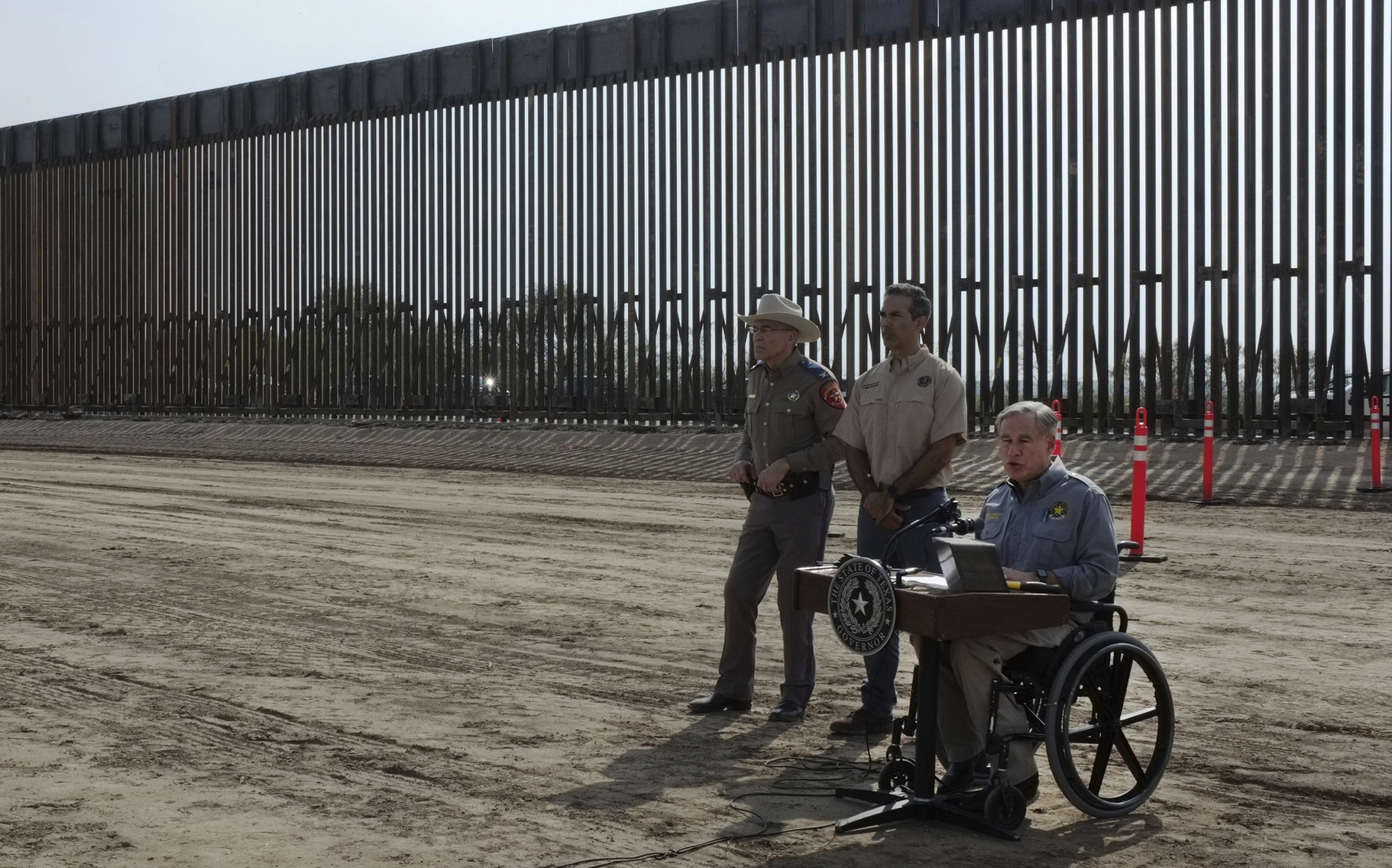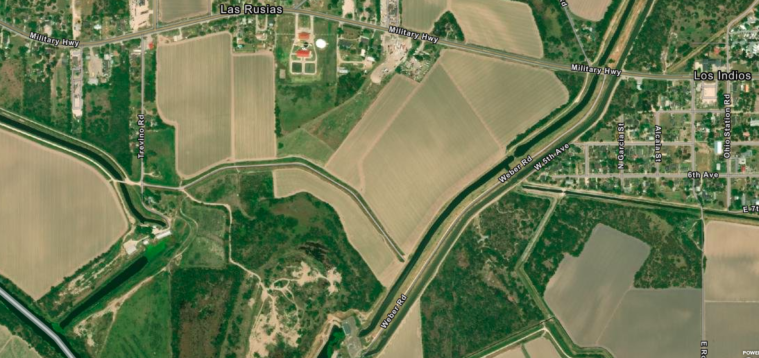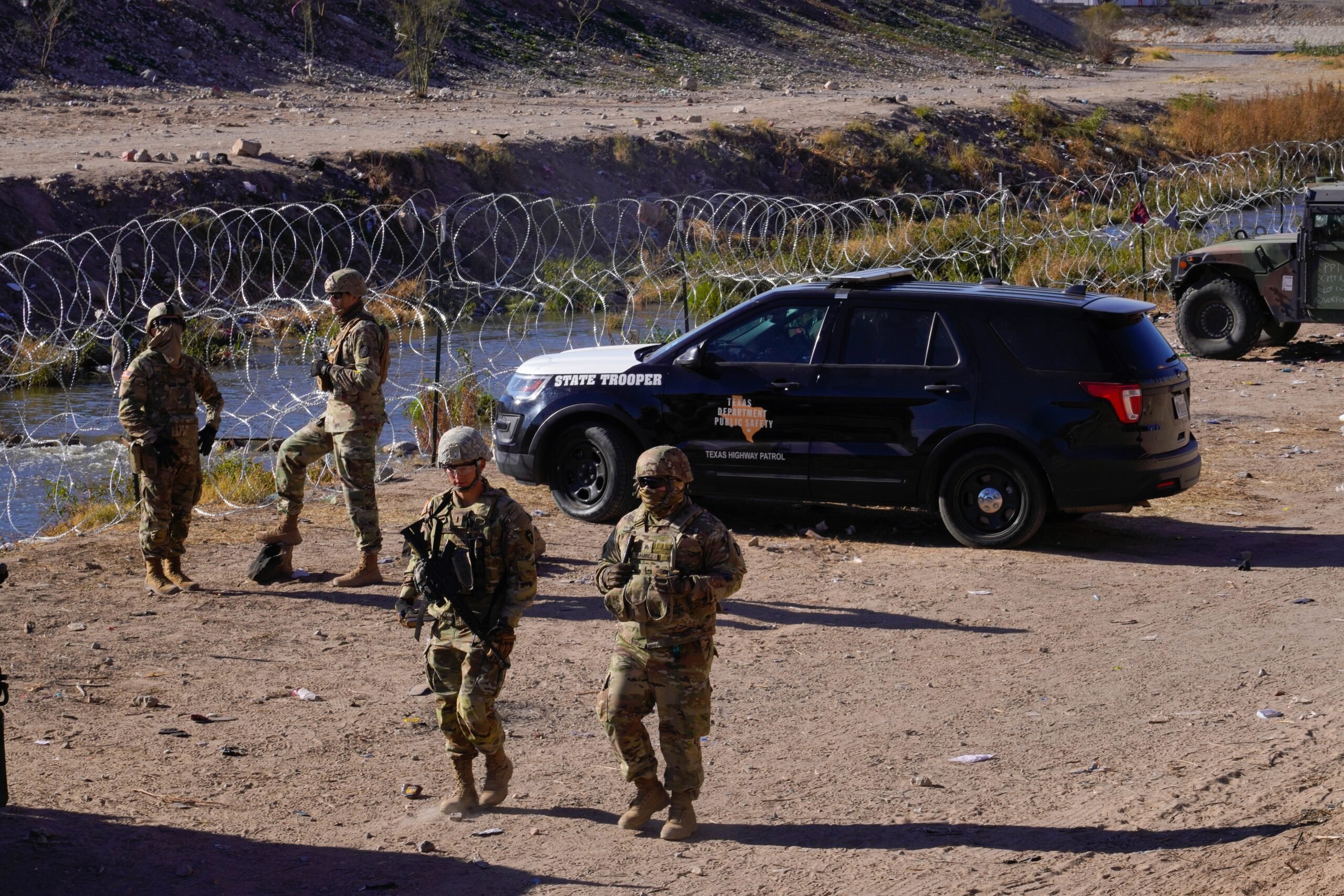
Records Shed Light on Abbott’s Secretive Border Wall Boondoggle
As Texas’ construction plans ramp up, records show the state has spent at least $220,000 on rural properties in Cameron and Val Verde Counties.

It’s been over a year since Governor Greg Abbott first unveiled his plans to use state money—with about $1 billion earmarked—to carry out former President Donald Trump’s dream of building a “big, beautiful wall” along the Texas-Mexico border.
So far, the realization of those plans—not counting some stretches of razor wire-topped chain link fence, stacked shipping containers, and concrete highway barriers—has been limited to a remote parcel of public land in rural and flood-prone Starr County owned by the Texas General Land Office, where contractors recently completed just under two miles of 30-foot-tall steel bollard fencing.
Despite the sluggish progress, Abbott ostensibly intends to erect several hundred miles of additional wall along Texas’ southern frontier, a key component of his sprawling border security scheme known as Operation Lone Star, which aims to supplant federal responsibility for immigration enforcement and border security.
Most of Texas’ 1,254-mile border—which is largely held by private landowners—is without any barrier but the Rio Grande. Roughly 150 miles have been walled off, overwhelmingly erected in bits and pieces by the federal government under prior presidential regimes. Like these federal efforts, Abbott’s plan requires building on private property along or near the river. But, unlike the feds, the state is prohibited from using eminent domain powers to seize land for the wall, thanks to an amendment to the state’s multi-billion-dollar border security funding bill passed in 2021. That means the state’s plans hinge on private landowners willingly selling (or donating) their property, which has proven a slow, costly, and secretive process.
“It’s a real weakness in the [public information] law that the government can claim that they don’t want the public to know how much money they’ve spent. … I can’t think of anything more fundamental that ought to be public.”
The Texas Facilities Commission (TFC)—a backwater agency that Abbott charged with orchestrating his border wall—has tried to keep a tight lid on the details of how it’s using $1 billion in taxpayer funds. In response to multiple open records requests from journalistic outlets including the Texas Observer, the agency has fought to withhold information about where it’s planning to build, which landowners it’s targeting, how much it thinks that land is worth, as well as how much it’s paid for land it’s already acquired, claiming that doing so would harm the state’s interest in negotiations with landowners and potentially delay or derail the project.
“It’s a real weakness in the [public information] law that the government can claim that they don’t want the public to know how much money they’ve spent because they’ve got more money to spend,” said Bill Aleshire, a longtime Austin attorney focused on government transparency. “I can’t think of anything more fundamental that ought to be public [than state spending]. They could be buying land for $1 million an acre and the public won’t know.”
Despite the state’s stonewalling, the Observer has reviewed previously unreported public data from the Texas Comptroller and records of TFC’s land easement agreements that together provide an unprecedented peek into what the state is paying for Abbott’s wall and where said wall is being built.
TFC has paid $220,894 to owners of 17 parcels of land in Cameron and Val Verde counties, as of November, per the Comptroller database that logs government expenditures. That’s in addition to the $125,000 paid to the General Land Office for leasing its Starr County land.

Meanwhile, the easement records show the wall is headed for nine properties near the rural farming town of Los Indios in western Cameron County. The size of these easements are mostly less than an acre. But the amount of money the state paid—between June and July of this year, per the Comptroller data—has varied dramatically from $6,600 for 0.85 acre of cropland owned by a group of family members to about $7,500 for 0.35 acre of land owned by a municipal irrigation district.
The easements give the state land rights to “construct, maintain, operate, inspect, and repair border wall infrastructure,” including but not limited to “all aspects of law enforcement and apprehension including but not limited to infrastructure for monitoring equipment, communications, and lighting.” They also include a clause that allows the state to transfer its land rights to the federal government at any point. The Facilities Commission said the construction start date for the Los Indios wall is still undetermined.
“They may or may not build any of this stuff. That’s not the point. It’s just red meat for the [Abbott] campaign,” said Scott Nicol, a longtime anti-border wall activist in the Rio Grande Valley. “Walls have absolutely no effect. It doesn’t matter if there’s a wall or a gap at Los Indios. If building hundreds of miles didn’t have any effect, why would building one more mile do the trick?”
The land that the state is acquiring near Los Indios would fill in a small gap—less than a mile wide—between existing federal border fencing first built over a decade ago. Easement records show the state plans to erect its border wall just north of a levee road, along a stretch of land that features stands of trees and farmland. The Trump administration had planned to add new segments in this area, including this exact same gap. While Congress appropriated those funds, construction was halted when President Joe Biden took office.
Los Indios native Rick Cavazos is well acquainted with the area. As a U.S. Border Patrol agent in the 2000s, Cavazos frequently patrolled the dirt roads that cut through the land above the Rio Grande. He says that the miles of border fencing built in the area back then were primarily meant to divert migrant and smuggling traffic away from residential areas and toward gaps like the one Abbott wants to fill.
“I’m not really sure what the logic is [for the state to build here],” Cavazos said. “What’s going to happen is, if you were to close that off, you’re going to just push the traffic” into nearby neighborhoods. “And that’s what we were trying to prevent.”
Asked about how it’s prioritizing where to build new wall, the Facilities Commission told the Observer: “The Texas Border Infrastructure alignment is developed under the direction of DPS.” DPS referred the Observer—for unknown reasons—to the General Land Office. The Land Office did not respond to Observer emails and calls, and U.S Customs and Border Protection didn’t respond either.
In a contract agreement, the Facilities Commission’s project manager, Michael Baker-Huitt Zollars, stated: “The initial priority locations shall be coordinated with DPS and focus on rural areas to allow for rapid initial land agreements and construction.”
“They may or may not build any of this stuff. That’s not the point. It’s just red meat for the [Abbott] campaign.”
The landowners who’ve signed easements with the state run the gamut from local residents and municipal entities to out-of-towners with inherited land rights. The state has one easement agreement with the Harlingen Irrigation District ($7,500 for rights to one-third of an acre) and is seeking agreements with Cameron County Irrigation District #2 and the City of Brownsville, according to local officials.
The state has also paid $130,000 to six landowners in Val Verde County, about 400 miles to the west, where contracts show it is planning to build several miles of wall near Del Rio. The state has no easements recorded in the local county clerk’s office.
The Facilities Commission is under immense pressure to obtain the necessary rights from hundreds of landowners, despite the agency having no prior experience with this type of large-scale project. The agency has already awarded over $450 million for three construction contractors to build about 22 miles of wall. But none of that can happen until it has the land.
Last September, the Facilities Commission awarded the engineering firms
Michael Baker—a major contractor on past federal wall projects—and Huitt Zollars a joint $10 million contract to orchestrate the state’s border construction project. The cost of those services has since more than doubled to accommodate for a more expensive and complicated land acquisition process, according to contract amendments approved by the agency.
“This program is an all-hands-on-deck priority for our agency, obviously, and we’re moving forward as quickly as possible,” TFC Executive Director Mike Novak said at an October commission meeting. “There’s not one easy thing about this but we’ve really loaded that pipeline now, and we’re making great progress.”
The Trump administration’s border wall project was plagued by excessive costs and delays resulting from poor planning. Ultimately, the ex-president constructed far less than he’d hoped, especially in Texas. In the quest to carry this mantle onward, Abbott’s administration may be headed in a similar direction, and so far they’d rather Texans not know too much about it.



